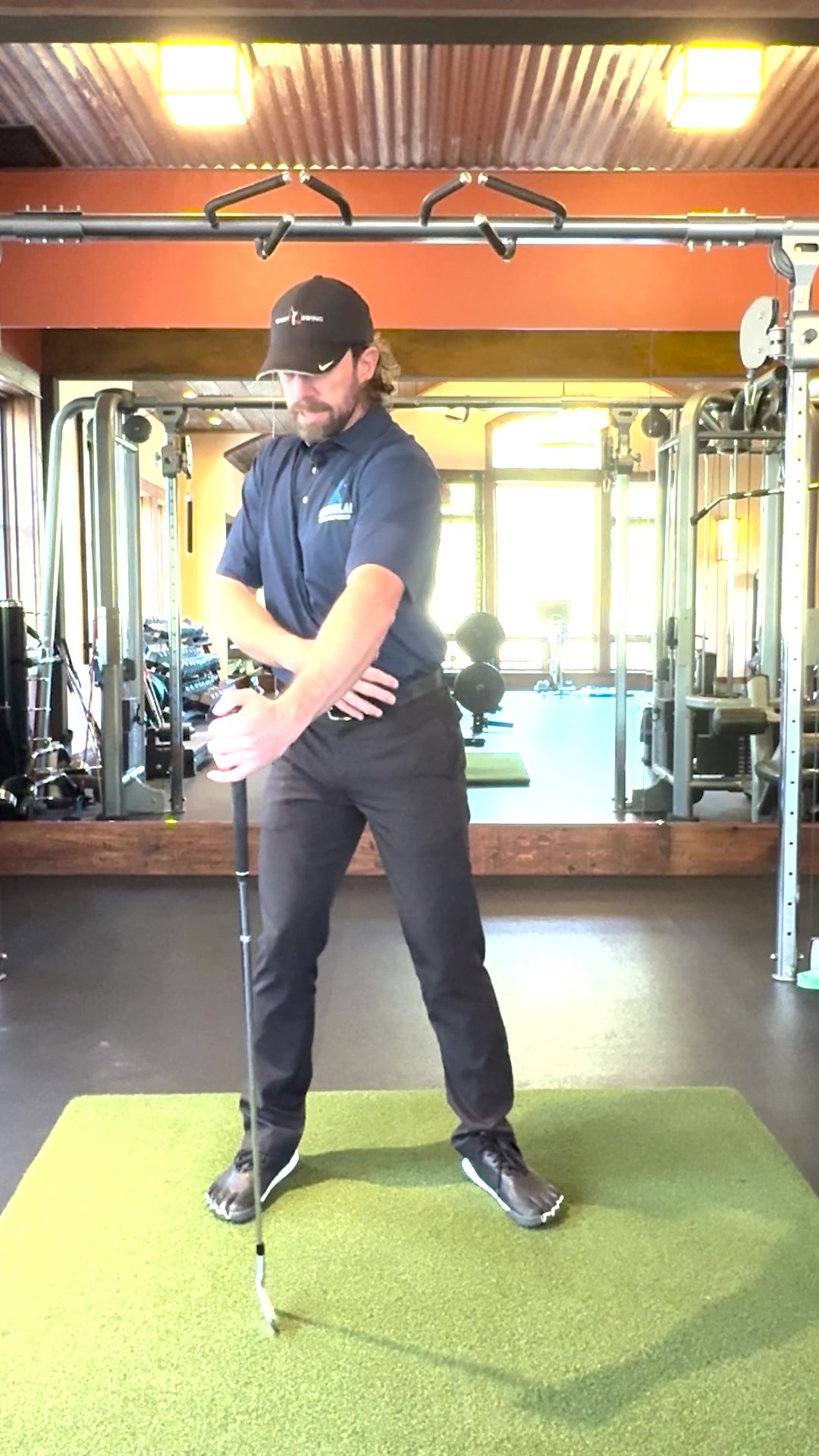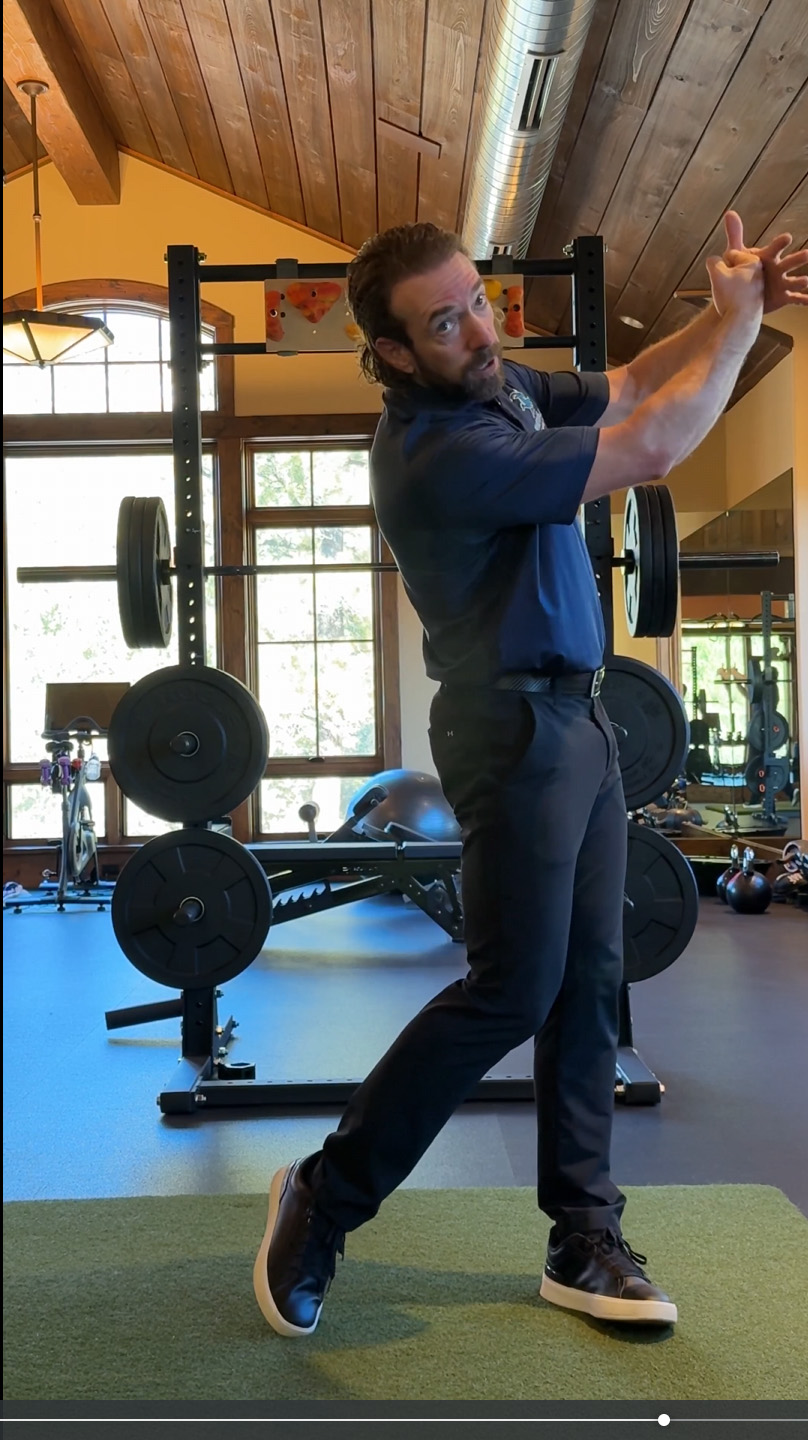To this day, tour and teaching pros, ordinary players, and commentators continue to search for the secrets of the Ben Hogan golf swing.
And that’s not surprising. As the winner of nine Majors and one of only five men to have completed the career Grand Slam, Hogan is undoubtedly one of the greatest golfers ever.
But his reputation within the game rests not so much on his impressive haul of trophies as on his legendary ball striking. Putting problems prevented him from winning even more tournaments, but from tee to green he has had few if any equals.
He also wrote bestselling instructional books that were way ahead of their time and made a major contribution to the theory of the golf swing.
The Ben Hogan Golf Swing Guide
So, what did Ben Hogan regard as the key elements of a sound golf swing?
Countless hours on the practice range convinced him that success boiled down to just a few closely related fundamentals – grip, stance and posture, backswing, and downswing.
Apart from the very first movement back to the ball – a turn of the lead hip -Hogan believed that a good downswing happened too quickly to be consciously controlled and depended largely on a sound backswing.
A good backswing depended in a similar way on a correct stance and posture. But no amount of work on perfecting any of these elements could compensate for a poor grip.
How to Imitate the Ben Hogan Golf Swing Technique
Assuming a sound grip, stance, and posture, the number one key that Hogan insisted on was to think of the swing as a rotation of the body, led by the hips, with minimal conscious involvement of the hands and arms.
And he gave a marvelous demonstration of a simple drill to help develop such a swing on Ed Sullivan’s Toast of the Town show.
https://www.youtube.com/watch?v=_AmPuzgBXEM
The Ben Hogan Golf Swing - Elbows
Starting with his elbows tucked into the sides of his waist he begins slowly turning his hips and body to set the club in motion and give the feel of the rotation with arms attached to the body firmly but without tension.
Gradually he lengthens the movement until, with upper arms against his chest and elbows pushed towards each other, he reaches full speed. Swinging back and forth without a pause and without a ball he is rewarded by a very audible “whoosh” as the club releases with the enormous power generated by proper lag.
“It’s simple,” he says, “anyone can do that”.
Perhaps he’s teasing us a little as he recalls the long years of work that it took him to make the game look so easy.
But there’s no doubt that the regular practice of this drill and the many others based on the Ben Hogan golf swing will work wonders for the quality of your ball striking.
FAQs
Did Ben Hogan have the best swing?
Ben Hogan had the best golf swing for HIM. His set up for alignment and posture are great aspects to emulate but you need to find the best golf swing for you and the Rotary Swing is a method to learn.
How do you swing a golf club like Ben Hogan?
Ben Hogan’s book has claimed to have created “a Nation of Slicers” and isn’t a great swing to emulate.
Who has the most technically perfect golf swing?
The most technically perfect swing is the swing that works for you. Check out the RotarySwing as a great start for a swing concept that can work for you.
Did Ben Hogan have a single plane swing?
Yes, but that probably is not the best fit for you. The RotarySwing is a simple golf swing anyone can learn.
Ben Hogan has long been marveled for his athletic and pure golf swing. His ball striking was unparalleled during his prime, and his swing was poetry in motion. He had many admirers of his swing, but few were able to capture the athleticism and grace that defined his move to replicate it at a professional level. There are a great number of things to be learned from Mr. Hogan's swing that I find both interesting and misunderstood and will take the time to point them out in the following synopsis. As a point of reference, I use a swing of Tiger Woods when he was playing extremely well, back in 2002.
Address
Fellow golfers who played with Ben often said his swing looked halfway done right from the setup position. His setup looked so solid that it just looked like he could never miss a shot. Below is a picture of Ben at address with a wood. Some interesting things of note in his setup: First, his left arm angled back away from the target at address rather than the classical more vertical position taught today. Interestingly, his position at address shares a lot in common with the Tiger Woods of "old", seen to the right in 2002. What I like the most about Hogan's left arm position here is that it is more into his left side. What I mean by that is that Ben's connection between his left arm and left pectoral muscle is very snug because he rotates his upper torso "into" his left arm at address, setting his shoulders open at address compared to his feet. This creates a very secure connection with the left arm and, thus, the club. The rotation of the body causes it to appear that his spine is tilted away from the target and that his shoulders are steeper than they really are at address because of the fact he is more open at address.
Hogan's right arm is something that has been discussed many times as well, but if you understand how his left arm was more into and across his chest, then you understand how this position simply pushes his right arm more away from his body, and the target, at address. Most golfers are the opposite, reaching more across their body with their right arm while their left arm is less connected. You can see that Hogan's right arm is hanging pretty loosely here, very relaxed.
If you look at Hogan's left knee, it appears to be pointed more toward the target when compared to Tiger's on the right, which is pointing more toward the ball. This is also due to the way Hogan set his body into his left arm, opening his hips at address as well, which rotated his leg toward the target.
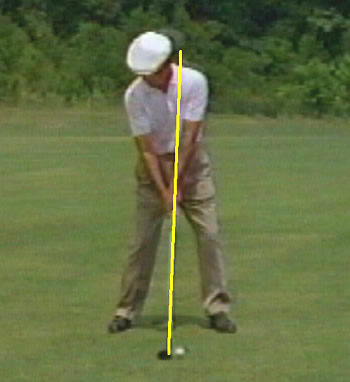
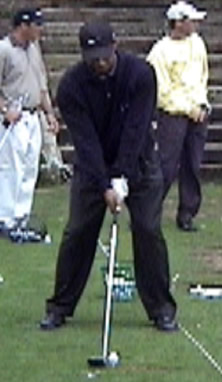
If you look at the yellow line I've drawn above, you can also see how Hogan leaned the shaft slightly toward the target at address, even though his hand position was more in the center of his body. You will often see golfers of the modern era with their hands at address more into their left thigh, as you can see in the picture below of David Toms. You can see that David's shaft is more vertical at address, and his hands are clearly more into his left side as the inner part of his thigh is hidden behind his hands. This position makes it easier to work the arms out away from the body during the backswing, creating more width and keeping the club and arms more in front of the body.
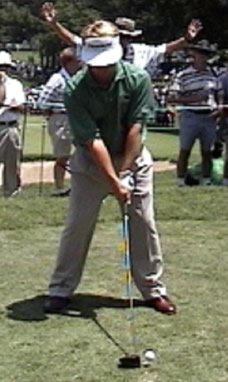
Backswing
As Ben took the club back, he had a fair amount of width in the backswing, contrary to a popular belief. You can clearly see here that his right arm has hardly begun to bend as the club reaches parallel to the ground, and his hands are a good distance away from his right hip. What can't be clearly seen from the face on view is the the club has moved much more to the inside than Tiger's has on the right. Tiger has taken the club back more to the outside while Ben has begun to swing the club more around his body.
Hogan has done little more than rotate around his spine at this point, with zero lateral movement of his head or hips. His hips have begun to rotate more than Tiger's, but they haven't shifted in any way because Hogan's right leg was like a post. He spoke about this in his book, "Five Lessons", and considered it a serious mistake to let the right leg shift away form the target during the backswing, demonstrating he favored rotation over lateral motion.
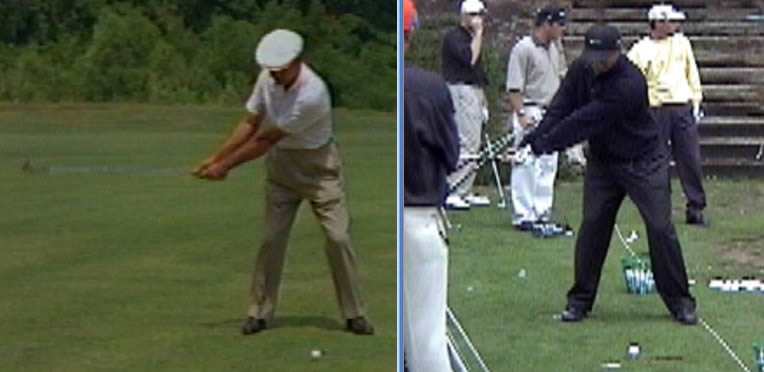
Second Half of the Backswing
While Hogan's arms were very quiet during the takeaway, the second half of his backswing tells a different story. Once the club reached parallel, Hogan's right arm begin to fold and work back behind him dramatically as can be seen in the sequence below. Everything else in Hogan's swing has remained very quiet to this point. His hips have moved very little, and his head has also moved very little. He's done little more than turn his upper torso and begun to swing his right arm behind him while folding at the elbow.

When compared with Tiger below, you can see how much later Tiger set the club in the backswing in an effort to create as wide an arc as possible. Hogan was quite the opposite. Once his takeaway was complete, his swing arc became very narrow and more around his body with a fair amount of wrist set by the time his left arm was parallel to the ground. Tiger has a later wrist set to achieve a wider arc for more power in his swing.
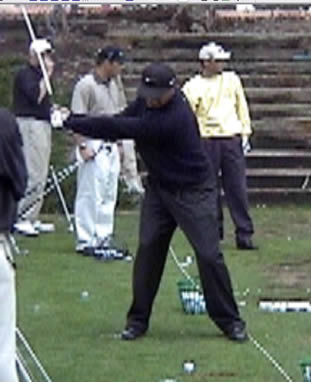
Head Movement
Ben Hogan's head remained very still throughout the golf swing, but it is a myth that it didn't shift laterally at all. As you can see in the photo below, Hogan's head did in fact shift off the ball from his address position, as can be seen by the red line in the photo below that represented where his head was at address. Hogan's nose was actually almost over his foot during the backswing, far from being in the center of his stance, as many people believe.
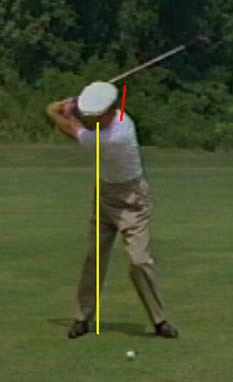
Transition
The screen shot below is taken at the first possible frame where there begins to be the slightest hint of the transition back to the left. Interestingly, they happen with the club in similar positions at the top of the swing, just short of parallel, for both golfers. Hogan's right leg has been a pillar, never moving off the target more than a half inch. The interesting thing from here is that Tiger's club is about to start going the other way while Hogan's will travel back quite a bit farther to complete his much longer backswing. Tiger made a more compact swing in this sense, as Hogan's club will dip well past parallel. This is where you will start to see how Hogan's hands were more involved in his swing. His left arm will not move much farther, but his wrist cock will incease significantly to finish the backswing.
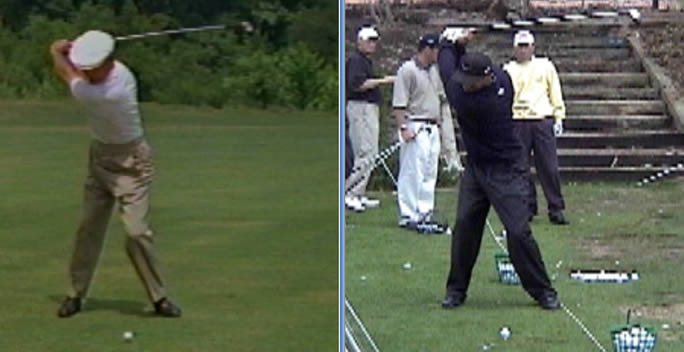
Top of Swing
At the top of the swing, Hogan has made a very strong move into his left side and will continue this move into his downswing, it will NOT stop during the transition. In fact, this move to the left will continue very late into his downswing as you will see later. Hogan has made a nice, full shoulder turn, but no where near that of Tiger's as Hogan finished his swing more with increased wrist cock than anything else. Tiger's shoulder turn is massive, yet he has kept his arms more in front of his body and the club from going past parallel, demonstrating excellent control of the club with his hands and arms. Another interesting note that is often commented on is the amount of lag that Hogan maintained late into his downswing. If you look at the wrist angle at the top of his swing when compared to Tiger or that of most any other Tour professional, it becames obvious where part of this lag stems from. The angle created by his shaft and left arm is dramatically sharper than Tiger's and will actually increase during the downswing. It will appear to increase more than it actually does because of the fact that he flattens the shaft on the way down to get the club right back on the exact plane he swung the club back on during the backswing.
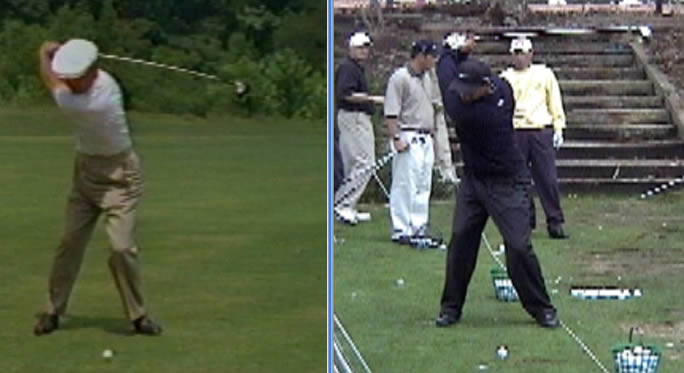
Downswing
As we move into the downswing, you can see some striking things about both of their swings. First, Hogan has increased his wrist cock due to his dynamic transition, flattening of the shaft and tensio-free hands. Tiger has about the same amount of wrist cock he had at the top of the swing, or slightly more, but nowhere near that of Hogan. The clubhead is directly above Tiger's head and Hogan's is still completely on the other side of his body by almost a foot when their left arms reach parallel to the ground. Both have begun to make aggressive moves into their left sides, with Tiger's being more pronounced at this stage in the swing. The yellow lines represents their left hip at the top of the swing. You can see that both have moved past it early in the downswing.
Also noteworthy is the position of both golfers' right elbow. Hogan's is clearly beneath his left arm and close to his body, while Tiger's is just slightly below his left and away from his torso in an effort to keep his arms and club more in front of his chest.
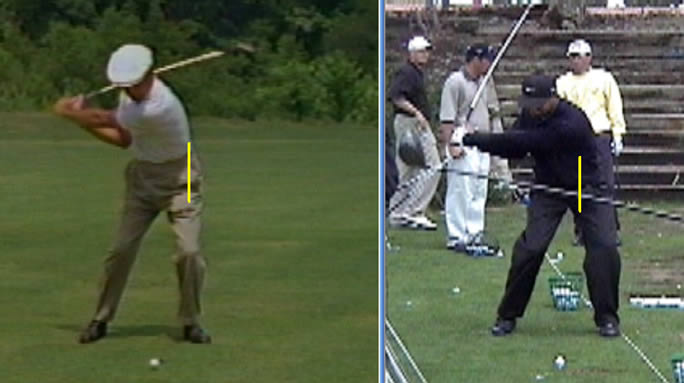
In the photo below, you see a position that is coveted by so many golfers, but is not something that should be attempted to achieve in most golf swings. Hogan has achieved so much lag in his downswing through the dynamics of his swing that he will have to wait on the club to come through impact and aggressively rotate his left forearm through impact to square the clubface because, at this point, it's wide open with a cupped left wrist. The only way to physically achieve this much lag is to have a cupping in your left wrist because if it is flat or bowed, it simply cannot be cocked this much; the wrist joint won't allow it. Hogan will go from a severely cupped left wrist late in the downswing to a severely bowed left wrist at impact in just a matter of milliseconds. It takes phenomenal hands to time this consistently. Also note that Hogan has continued to move past the yellow line at this stage in the downswing. In other words, his hips have continued to slide toward the target very late into the downswing.
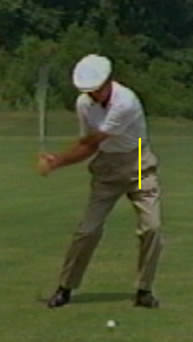
Nearing Impact
Amazing how similar their positions become at this point in the swing after all the variations earlier. Hogan's massively powerful hip drive has bowed his left leg dramatically, actually getting his left knee out past his left foot. His spine has tilted back here, as has Tiger's as they prepare to deliver the blow, but it appears to be more than it really is because the rotation creates this illusion. At this point in the swing, they also have basically the same amount of lag. Tiger got into this position without nearly the amount of timing required for Hogan's massive wrist cock and long backswing. Both are rotating very aggressively at this point, and it is here that their lateral movement has ceased.
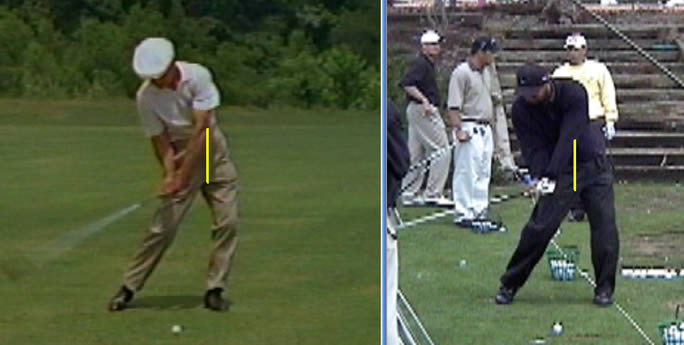
Impact
Two masters at work here. Pure poetry in motion. The two most obvious differences are that Tiger has really released his arms and hit hard through impact, achieving his primary objective of getting his arms and club in front of his body at impact. Hogan, on the other hand, has kept his right elbow back at impact and his arms closer to his body. You can see that his right arm is still bent compared to Tiger's, which is very straight. Both have made dramatic moves into their left side and are rotating their bodies at great speed. Hogan has moved so hard into his left side and is rotating so hard that his right heel is well off the ground. Both golfers have kept their heads well behind the ball at impact, creating an obvious reverse "C" or "K" position at impact that is apparent in golfers who use their hips as a significant source of power because the lower body is much more open and ahead of the upper body.
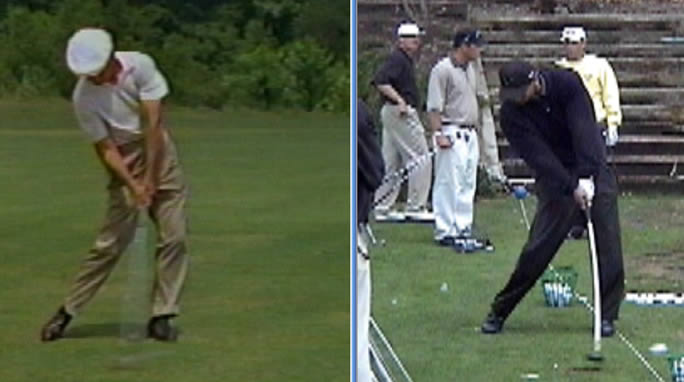
Follow Through
At this position in the follow through, you can see how much more open Ben's body is to the target. Where Tiger has flung his arms and hands through impact with authority, Hogan has rotated his body much more to the left than Tiger has. Even with Tiger's amazingly fast hips, Ben is much more open, his hips and chest completely facing the target. Hogan used his whole body as a source of power, especially his hips, and that can clearly be seen here.
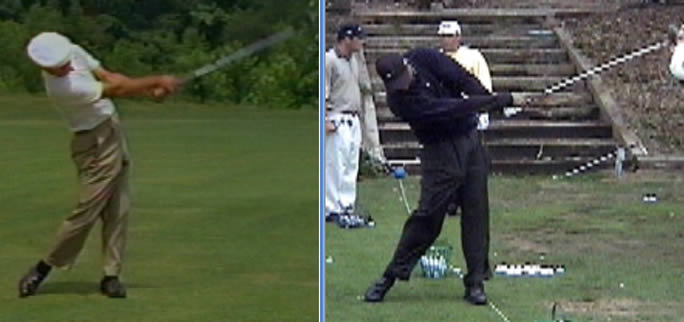
In this second picture of their follow throughs, you can see that Hogan's body has continued to rotate left while Tiger's arms have continued to release more. The angle between the club and the right forearm of Hogan is also less severe. This is because he kept the club from releasing to avoid hitting it left. Golfers who release the club, or the toe of the club more specifically, agressively through impact such as Tiger and Ernie Els tend to hit some nasty hooks on occasion when the timing of this release is off. Hogan learned that by keeping this release from happening he could mitigate his tendency to hook. Also note how flat Hogan's shoulders are in comparison to Tiger's. You can barely see his left shoulder compared to Tiger's, which is well above his right.
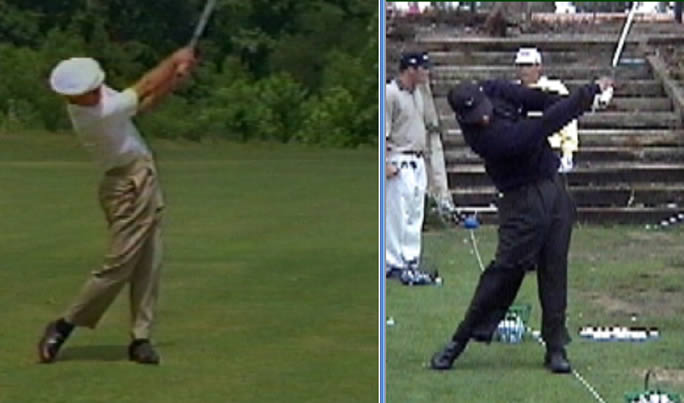
Finish
Two beautiful finish positions in marvelous balance. Tiger's aggressive release of his arms has his left arm much further behind him, and the club is much more released as mentioned earlier. Hogan's finish is much shorter because he didn't release the clubhead in the same way.
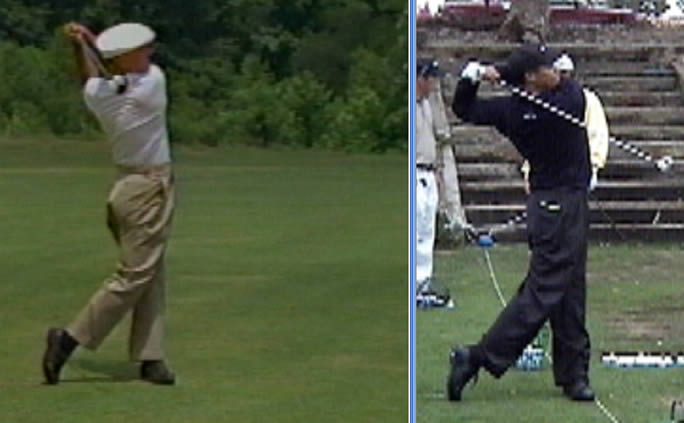
Conclusion
There are so many amazing things in these two golf swings that make them a joy to watch. Both produced fantastic results and had many similarities and differences. Of important note is that Hogan essentially built his swing around avoiding a hook. Tiger also fought a hook in his younger days, but used it to his advantage to get more distance. Hogan despised the shot and did everything he could to virtually eliminate the left side of the golf course. Unfortunately, a great number of amateurs never see the left side of the golf course because their misses tend to be the other direction and copying Hogan would really only exacerbate that problem for the majority of amateurs.
I think it is important to dispel some myths about Hogan's swing that can be clearly seen from the video. First, Hogan was very handsy in his swing. His incredible late lag required that he wait on the clubhead and that he square the clubhead through impact with his hands because the club face was very open coming down. He did this through his famous "supination" of his left wrist and forearm, rolling them over at the last instant to get the clubface square. Because he had a great sense of the clubhead through beating more balls than most any other professional in history, he learned to control this over a great period of time. Vijay Singh is another golfer who dramatically rolls his left forearm through impact in order to square the clubface and he too hits a ton of golf balls in order to keep his timing in check. They also both hit fades as their predominant shot because it is much easier to control and time the release of a slightly open face rather than trying to return it perfectly to square or rotate it slightly closed to hit a draw when the club is travelling at such great speed.
Second, Hogan had a very large lateral move through the ball that continued late into his downswing, contrary to some people's belief. It did NOT stop during the transition. Hogan's left arm was atleast parallel to the ground in the downswing before he stopped moving into his left side, if not even later. You can also see a similar move in Tiger's swing, although he actually posts up more into his left leg coming into impact. Hogan's drive both laterally and around was so strong it bowed his lead leg toward the target. This is a very clear sign that Hogan used his tremendous lower body movement to generate a great deal of power in his golf swing.
Third, Hogan's right elbow. There has been a lot of discussion about this throughout the years. No doubt, Hogan's elbow stayed behind his right hip until very late in the swing, but keep in mind, Hogan was striving to hit a fade, and as you can see from his follow through, held off the finish to keep the toe of the club from turning over aggressively. I agree that keeping the right elbow back is a fine way to strike the ball because keeping the arms in close to the body allows the body to not only dominate the swing and control the arms, but rotate faster as well. Part of the reason that Hogan kept his right elbow back so far was because he was, in essence, out running his arms and club to the finish with his body by sliding and aggressively turning. The faster the body moves and the more passive the arms, the easier it is to keep the arms back, but the dramatic lateral movement helps this move happen to a large degree. If you stand in one place, staying completely centered, and just rotate as fast as you can with passive arms, it is much more difficult to keep the right arm back through impact. However, if you couple this with a large lateral move, it is much easier to keep the elbow back until later in the swing. You can see a lot of both on Tour these days, but the prevailing fact for most is those who keep their right elbow up and back tend to miss right, and the opposite is true for those who release the arms through impact. To make a long story short, I prefer that the golfer not try and keep the right elbow back; rather, they should focus on their body rotation with passive arms, and the elbow will naturally stay back the right amount for their golf swing, as the arms will release naturally at the right time.
Watch part 2 now to see how you're moving your body in the opposite direction of the pros!




















































